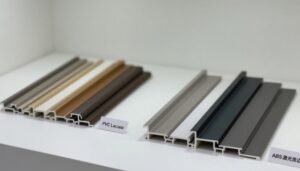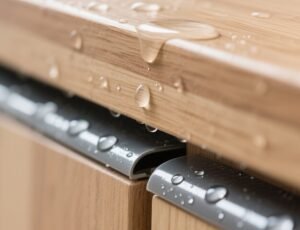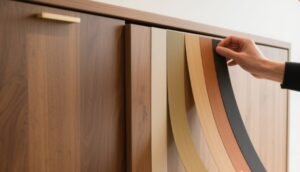Closet drawers look sleek outside but fall apart fast inside without the right edge banding. Don’t let a weak detail ruin your custom work.
Edge banding keeps drawer edges protected and smooth. The best kind depends on material, look, use, and how easy it is to apply.

Choosing edge banding isn’t just picking tape. For dealers like us, it’s about selling something that lasts, looks good, and fits what customers really want. Let’s break it down.
What Makes Edge Banding Ideal for Custom Closet Drawers?
Even the best-looking drawer fronts feel unfinished without proper edge banding. This one detail makes or breaks your product’s first impression.
The ideal edge banding must be durable, easy to apply, and match the overall closet style. It should also hold up through heat, moisture, and daily use.
Custom closets are high-end products. Customers expect flawless finishes and long-term durability. A chipped edge or lifting tape damages that trust. For dealers, the right edge banding means fewer returns and more referrals.

What makes it ideal?
| Factor | Why It Matters |
| Adhesion strength | Prevents peeling in humid or warm closets |
| Scratch resistance | Keeps drawers looking new over time |
| Color & texture match | Aligns with drawer fronts for seamless look |
| Thickness | Impacts both feel and durability |
| Application method | Affects cost and speed of manufacturing |
Choosing the right edge banding is like choosing a business partner—it needs to deliver consistently, even when no one is watching.
Which Edge Banding Materials Work Best for Closet Applications?
Not all materials perform the same. Pick wrong, and it’s either a return or a reputation risk.
PVC and ABS are top choices for custom closets. Both offer good durability, style options, and ease of use. But each has pros and cons depending on your market.
PVC vs ABS vs Others: What’s worth stocking?
| Material | Pros | Cons |
|---|---|---|
| PVC | Affordable, flexible, color variety | Can shrink over time with heat |
| ABS | Eco-friendlier, stable in heat | Slightly higher cost |
| Acrylic | High gloss, very durable | Expensive, harder to process |
| Melamine | Low cost, paper-backed | Low durability, scratches easily |
| Wood | Natural look, premium feel | Requires skilled application |
I usually lean toward ABS for drawers near heat sources (like built-ins near windows). But for general use, PVC hits the sweet spot of cost, flexibility, and finish.
How Does Edge Banding Impact Product Quality and Client Satisfaction?
You can build a perfect closet frame—but if the drawer edges chip in three months, the customer won’t care about the rest.
Edge banding defines the drawer’s feel. It also defines how long it holds up. Happy clients don’t call back unless they’re ordering again.

Three reasons clients care more than you think:
1. Touch & Feel
Edge banding is often the first thing someone touches. Rough or lifted edges feel cheap—even if the inside is solid hardwood.
2. Daily Use Damage
Closet drawers get pulled, pushed, and slammed. Weak edge banding shows damage fast. Strong ones stay smooth and clean.
3. Overall Finish
Even if it’s only 1mm thick, edge banding frames the whole look. If it doesn’t match or starts lifting, it breaks the harmony.
If we want fewer service calls, fewer complaints, and stronger word-of-mouth, edge banding deserves our full attention.
What Are the Top Edge Banding Options for Custom Closet Projects?
If I had to pick a short list to offer every dealer, it would be a balance of quality, variety, and supply availability.
The best edge banding options are not just materials—they’re systems that match your production workflow, storage needs, and product types.
My go-to lineup:
| Option Type | Why It Works | Ideal For |
|---|---|---|
| 1mm ABS Matte Finish | Scratch-resistant, modern look | Drawer fronts, mid-level closets |
| 2mm PVC Woodgrain | Premium wood look, easy handling | Walk-in closets, higher margin |
| High-gloss Acrylic Edging | Luxe style, durable | High-end showcase projects |
| Laser Edge Banding | Seamless finish, no glue line | Custom jobs, showroom pieces |
| Pre-glued Melamine Rolls | Fast application, low cost | Budget closet systems |
I always keep 1mm ABS in neutral colors on hand. It works for most projects, holds well, and customers rarely complain about wear.
How to Choose the Right Edge Banding for Your Closet Drawer Line?
With so many options, how do you choose what to stock and promote? It’s about balancing fit, finish, and function—plus what your market is asking for.
Start by aligning the edge banding with your drawer material, customer budget, and preferred workflow

Here’s how I decide
Step 1: Match with core panel
MDF and particleboard need stronger adhesive grip. For lacquered MDF, a seamless ABS or laser banding is worth the upgrade.
Step 2: Budget vs premium split
Offer at least two tiers. Basic PVC for standard closets, and high-end acrylic or laser edge for premium clients.
Step 3: Color and texture matching
Clients notice mismatches. Stock edge banding that matches your most-used board finishes.
Step 4: Vendor support
Choose suppliers with reliable delivery, consistent color batches, and responsive support. A missed shipment delays everything.
Edge banding is the last step—but it’s often the first thing the client sees. Pick like it’s your brand’s signature—because it is.
Edge banding isn’t just a trim. It’s a promise of quality, and in custom closets, that promise better hold strong.




